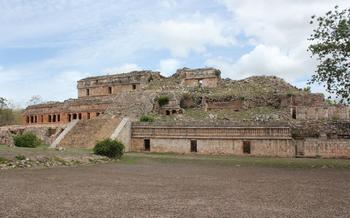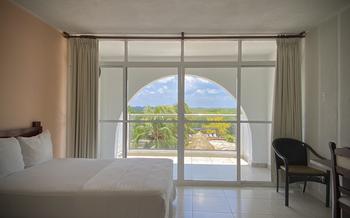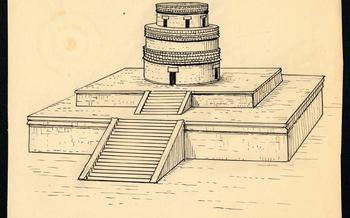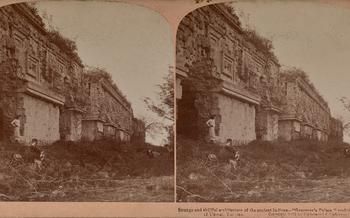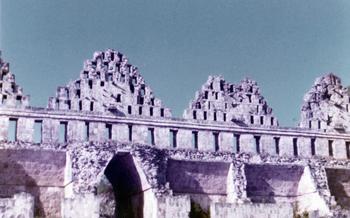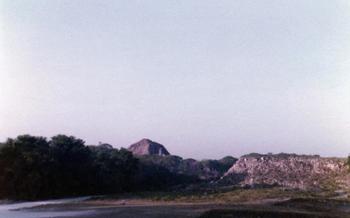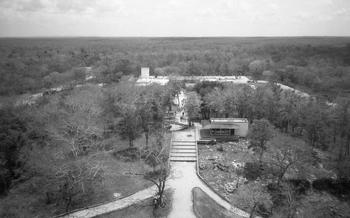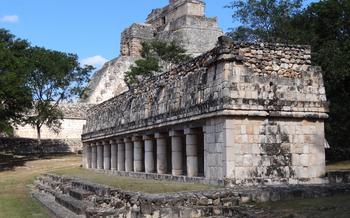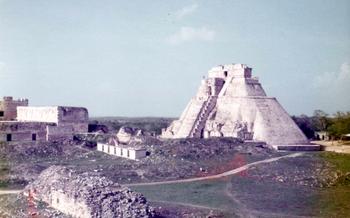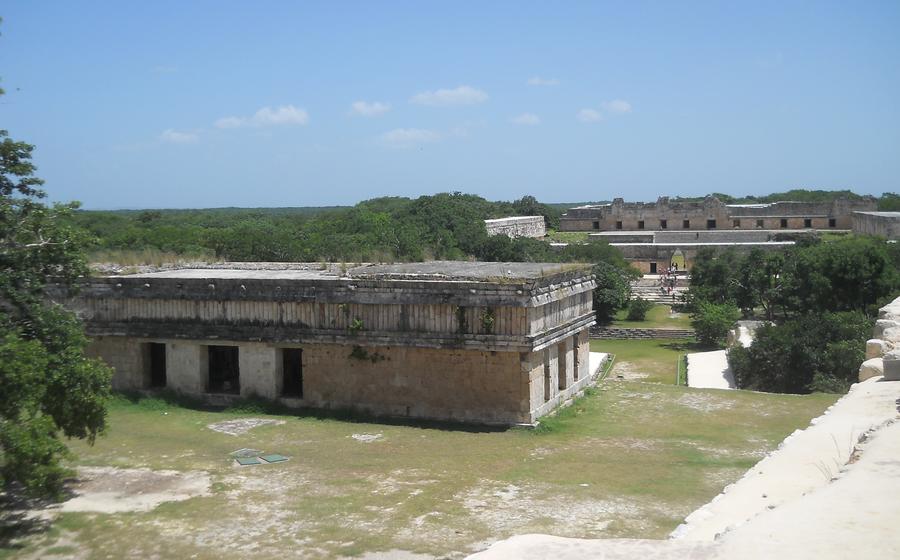
Casa de las Tortugas
- Uxmal's Historical Significance:
- Exploring the Casa de las Tortugas
- Architectural Marvels
- The Turtle Frieze: Symbolism and Preservation
- Rooms and Spaces
- Maya Daily Life
- Restoration and Preservation
- Immersive Experiences
- Local Cuisine and Crafts
- Nearby Attractions
- Sustainable Tourism
- Photography Tips:
- Family-Friendly Activities
- Insider Tip: Unveiling Hidden Gems and Unique Experiences
Uxmal's Historical Significance:
Uxmal, a prominent ancient Maya city, flourished between 700 and 1000 AD in the Puuc region of Mexico's Yucatán Peninsula. It served as a significant political and cultural center, rivaling other Maya metropolises like Chichén Itzá and Tikal. Uxmal's well-preserved ruins, showcasing a unique architectural style characterized by intricate stone carvings, corbelled arches, and towering pyramids, have earned it recognition as a UNESCO World Heritage Site. Among its many impressive structures, the Casa de las Tortugas stands out as a remarkable testament to the Maya civilization's architectural prowess and cultural significance.
Exploring the Casa de las Tortugas
The Casa de las Tortugas, aptly named for its intricate turtle frieze, holds a significant position within the ancient Maya city of Uxmal. This residential palace, once home to high-ranking Maya officials, offers a glimpse into the lives of the city's elite. Its strategic location, overlooking the main plaza, highlights its importance in the administrative and ceremonial center of Uxmal. As visitors step inside the Casa de las Tortugas, they are transported back in time, experiencing the grandeur and opulence of Maya architecture and immersing themselves in the rich history of this ancient civilization.
Architectural Marvels
The Casa de las Tortugas stands as a testament to the architectural prowess of the ancient Maya. Its intricate stone carvings, corbelled arches, and imposing façade captivate visitors with their beauty and symbolism. The exterior walls are adorned with detailed depictions of Maya deities, mythical creatures, and scenes from daily life, offering a glimpse into the rich cultural heritage of the region.
The corbelled arches, a hallmark of Maya architecture, are a testament to the builders' engineering skills. These arches are formed by overlapping layers of stone, creating a stable and durable structure without the use of mortar. The façade of the palace is equally impressive, featuring a series of carved panels that tell stories of Maya history and mythology.
The Casa de las Tortugas is not just a display of architectural prowess; it also holds cultural and religious significance. The carvings and sculptures that adorn the palace walls depict important Maya deities, such as Chac, the rain god, and Kukulkan, the feathered serpent god. These images served as a reminder of the Maya's deep spiritual beliefs and their connection to the natural world.
The Turtle Frieze: Symbolism and Preservation
Among the most captivating features of the Casa de las Tortugas is its intricate turtle frieze, which adorns the upper section of the building's façade. This frieze, composed of hundreds of intricately carved stone turtles, holds significant symbolic meaning in Maya culture. Turtles were revered as symbols of water, fertility, and the underworld, and their presence on the palace's façade represents the Maya's deep connection to the natural world and their spiritual beliefs.
The turtle frieze has undergone extensive restoration and preservation efforts to ensure its longevity. Archaeologists and conservators have worked meticulously to repair damaged sections, clean and stabilize the carvings, and protect them from further deterioration. Their efforts have been instrumental in preserving this unique and iconic frieze for future generations to appreciate.
Rooms and Spaces
The Casa de las Tortugas is a multi-room complex, each space serving a specific purpose in the daily life of the Maya elite. The main entrance leads into a large courtyard, surrounded by various rooms and chambers. These rooms include sleeping quarters, audience chambers, storage areas, kitchens, and workshops.
The sleeping quarters, located in the north and south wings, were used by the palace's occupants and their families. These rooms are relatively small and simple in design, with basic furnishings such as beds, mats, and storage containers.
The audience chambers, located on the east and west sides of the courtyard, were used for receiving guests, conducting meetings, and discussing important matters. These chambers are larger and more elaborately decorated than the sleeping quarters, with intricate carvings adorning the walls and doorways.
Storage areas, located at the back of the palace, were used to store food, water, and other resources. These rooms were typically dark and cool, helping to preserve the stored goods.
Kitchens, located near the storage areas, were used for preparing meals for the palace's inhabitants. These rooms contained hearths, ovens, and other cooking equipment.
Workshops, located near the kitchens, were used for various crafts and activities, such as weaving, pottery, and woodworking. These rooms were equipped with the necessary tools and materials for these activities.
The interconnections between the rooms and spaces within the Casa de las Tortugas are significant. The courtyard served as a central gathering place, connecting the different parts of the palace and allowing for easy movement between them. The arrangement of the rooms and chambers reflects the social hierarchy and functional needs of the Maya elite who resided in the palace.
Maya Daily Life
The Casa de las Tortugas was not merely a physical structure but a vibrant hub of activity, reflecting the daily rhythms of Maya life. Within its walls, high-ranking officials conducted important affairs of state, made decisions that shaped the city's destiny, and governed the lives of its inhabitants. The palace served as a center for administrative duties, where officials managed trade, agriculture, and construction projects.
Beyond its administrative functions, the Casa de las Tortugas also played a crucial role in the social and cultural fabric of Maya society. It hosted elaborate ceremonies, religious rituals, and celebrations that brought the community together. The palace's grand halls and chambers witnessed the exchange of ideas, the sharing of stories, and the strengthening of bonds among the Maya people.
Imagine the hustle and bustle of daily life within the palace's walls. Artisans, scribes, and servants moved about, performing their duties and contributing to the smooth functioning of the Maya household. The palace's kitchens hummed with activity as cooks prepared sumptuous meals for the elite and their guests, using fresh ingredients from the surrounding countryside.
The Casa de las Tortugas was not just a place of power and administration but also a testament to the Maya people's rich cultural heritage. It embodied their beliefs, customs, and traditions, providing a glimpse into the vibrant and sophisticated civilization that flourished in this ancient city.
Restoration and Preservation
The ongoing restoration and preservation efforts at the Casa de las Tortugas play a crucial role in safeguarding this ancient Maya palace for future generations. Archaeologists and conservators work tirelessly to protect the site from the adverse effects of natural elements, such as heavy rainfall and humidity, as well as human impact, including vandalism and accidental damage. Their meticulous efforts involve stabilizing and repairing the palace's structures, conserving the intricate carvings and murals, and conducting thorough research to gain a deeper understanding of the site's history and significance. Through these dedicated efforts, the Casa de las Tortugas continues to stand as a testament to the enduring legacy of the Maya civilization, inviting visitors to delve into its rich past and marvel at its architectural wonders.
Immersive Experiences
Enhancing your visit to the Casa de las Tortugas can be achieved through immersive experiences that bring the ancient Maya world to life. Guided tours led by knowledgeable experts offer insights into the palace's history, architecture, and the lives of its inhabitants. These tours provide a deeper understanding of the site's significance and allow visitors to connect with the past in a meaningful way.
Photography enthusiasts will find ample opportunities to capture the beauty of the Casa de las Tortugas and its surroundings. The intricate carvings, imposing façade, and lush vegetation create a picturesque backdrop for stunning photographs. Experimenting with different angles, lighting conditions, and composition techniques can result in captivating images that preserve the memories of your visit.
Local Cuisine and Crafts
Enrich your visit to Uxmal by savoring the authentic flavors of Maya cuisine. Local restaurants and markets offer a tantalizing array of traditional dishes, such as cochinita pibil, a slow-roasted pork delicacy, and panuchos, crispy tortillas topped with beans, meat, and vegetables. Indulge in the vibrant flavors that have been passed down through generations.
After exploring the Casa de las Tortugas, take the opportunity to support local artisans by purchasing traditional Maya handicrafts and souvenirs. Discover intricate textiles, colorful pottery, and hand-carved wooden figurines, each piece a testament to the region's rich cultural heritage. Your purchases not only support local livelihoods but also contribute to the preservation of ancient traditions.
Uxmal and the surrounding region pulsate with a vibrant cultural scene. Attend traditional dance performances, listen to enchanting Maya music, or participate in hands-on workshops to learn about ancient crafts and customs. Immerse yourself in the living culture of the Maya people and gain a deeper appreciation for their enduring legacy.
Nearby Attractions
In addition to the Casa de las Tortugas, Uxmal is surrounded by other significant archaeological sites that offer a glimpse into the grandeur of the ancient Maya civilization. Just a short distance away, visitors can explore the ruins of Kabah, renowned for its impressive arched entrance known as the Codz Poop. Sayil, another nearby site, boasts a well-preserved palace and a series of intricate carvings depicting various Maya deities. The site of Labná is also worth exploring, featuring a unique palace known for its elaborate decorations and a remarkable building known as the Mirador, which offers panoramic views of the surrounding landscape.
For those seeking an adventure beyond ancient ruins, the Grutas de Loltún, a vast cave system located just a few kilometers from Uxmal, is a must-visit. This subterranean wonderland features stunning stalactite and stalagmite formations, as well as cenotes and underground rivers. Visitors can explore the caves on guided tours, marveling at the intricate rock formations and the unique ecosystem that thrives within.
Sustainable Tourism
As responsible travelers, it is crucial to practice sustainable tourism while visiting Uxmal. Respecting the cultural and natural heritage of the site is paramount. Avoid touching or climbing on the ancient structures, as this can cause damage over time. Dispose of waste properly in designated bins to help preserve the pristine environment. Consider using eco-friendly transportation options, such as bicycles or electric vehicles, to minimize your carbon footprint. By embracing sustainable practices, we can ensure the preservation of Uxmal's treasures for future generations to appreciate and enjoy.
Photography Tips:
To capture the essence and beauty of the Casa de las Tortugas through photography, consider using a wide-angle lens to encompass the grandeur of the architecture. Experiment with different lighting conditions, especially during the golden hours of sunrise and sunset, to enhance the depth and warmth of your shots. Pay attention to the intricate details and carvings adorning the palace, as they often reveal hidden stories and symbolism. Utilize natural light to your advantage, as it illuminates the structures in a way that artificial lighting cannot replicate. Remember to maintain a respectful distance while photographing, ensuring that you do not disrupt the tranquility of the site or disturb other visitors.
Family-Friendly Activities
The Casa de las Tortugas offers a captivating experience for families with children. To enhance their visit, consider engaging them in interactive activities that bring the ancient Maya world to life. Organize a scavenger hunt, providing clues that lead them to discover hidden details within the palace. Storytelling sessions can also be a delightful way to immerse children in Maya myths and legends associated with the site. Plan your visit during special events or workshops designed for families, where kids can participate in hands-on activities like traditional Maya crafts or cooking classes. These experiences create lasting memories and foster a deeper appreciation for the site's cultural heritage.
Insider Tip: Unveiling Hidden Gems and Unique Experiences
Beyond the captivating sights of the Casa de las Tortugas, Uxmal offers hidden gems and unique experiences waiting to be discovered. One such gem is the nearby Cenote Azul, an enchanting natural swimming hole nestled just a short walk from the palace. Dive into its crystal-clear waters, surrounded by lush vegetation and ancient rock formations, for a refreshing and revitalizing experience.
For an unforgettable evening, plan your visit to coincide with the annual Uxmal Light and Sound Show. As darkness falls, the ancient city comes alive with a mesmerizing display of lights, projections, and storytelling that narrates the history and legends of Uxmal. Immerse yourself in the magic as the Casa de las Tortugas and other iconic structures transform into a canvas for this captivating spectacle.
